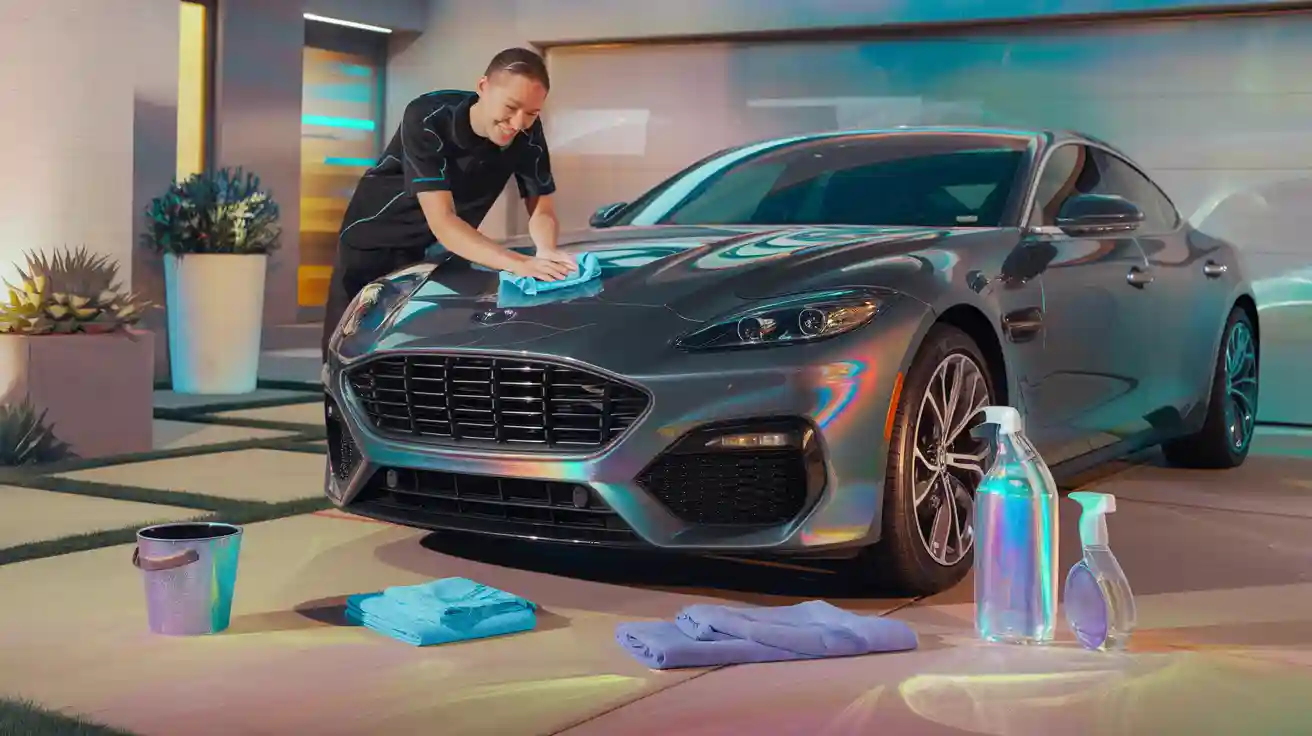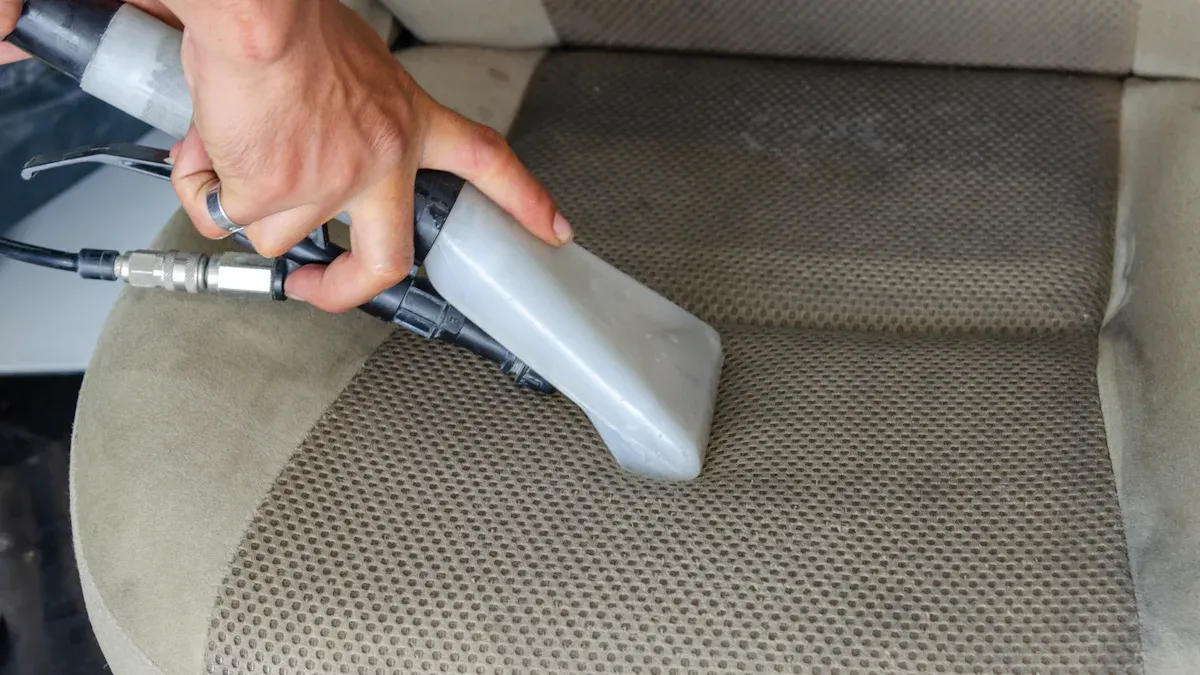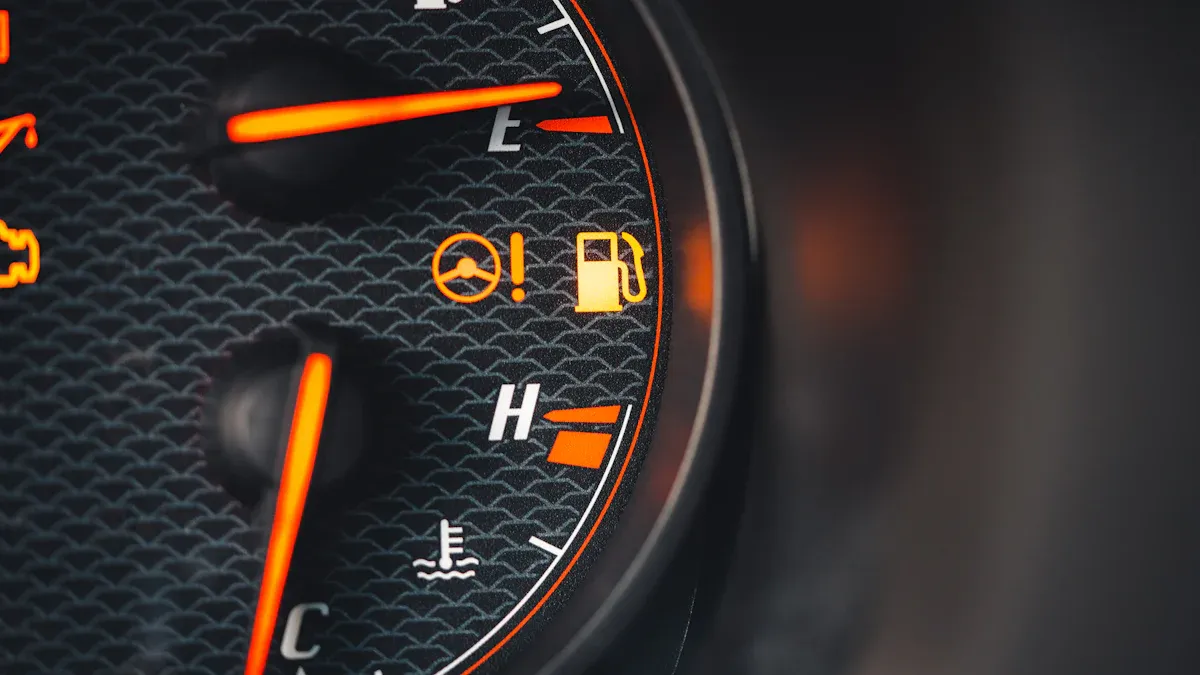
Taking care of your new car the right way means you stay ahead with smart habits. You protect your car’s value and avoid problems by following your manual, using trusted car care products, and sticking to regular maintenance. Even if you have never owned a new car before, you can do this. Check out how much you gain when you keep up with car care:
Benefit |
Statistic |
Source/Year |
|---|---|---|
Fewer breakdowns |
Fleet Equipment, 2022 |
|
Better fuel efficiency |
Trimble, 2021 |
|
Longer vehicle life |
2-3 years more |
Warranty Direct, 2022 |
You do not need special skills—just start with good habits and your new car will thank you.
Key Takeaways
Read your new car’s owner manual to learn how to use features and when to do maintenance.
Drive gently during the first 1,000 miles to protect your engine and help parts fit smoothly.
Check your car daily for flat tires, warning lights, and strange sounds to catch problems early.
Follow a regular maintenance schedule for oil, tires, brakes, and fluids to keep your car safe and reliable.
Wash your car often with pH-neutral products and protect the paint with wax or paint protection films.
New Car Basics
Owner’s Manual
When you get a new car, the first thing you should do is read the manual. This book tells you everything you need to know about your car. You will find out how to use special features, what each dashboard light means, and when to schedule basic car maintenance. Keep the manual in your glove box so you can check it anytime. If you ever feel unsure about a button or warning light, the manual has your answer.
Tip: Take a few minutes each week to flip through your manual. You might discover a feature you did not know your new car had!
Break-In Tips
Your new car needs a gentle start. The way you drive during the first 1,000 miles can make a big difference in how your engine performs for years. Here are some easy tips to follow:
Keep the engine speed below 4,000 RPM for the first 1,000 miles.
Change gears at low RPMs to help your engine and save fuel.
Avoid hard acceleration and do not floor the gas pedal.
Try not to take short trips. Let your car warm up fully.
Skip towing heavy loads until after the break-in period.
Drive gently so your tires, brakes, and suspension settle in.
These steps help the engine parts fit together smoothly. You will also protect your car from early wear and keep it running strong.
Features to Know
Every new car comes packed with cool features. Some help you drive safer, like automatic high-beam headlights or blind spot cameras. Others make driving easier, such as adaptive cruise control. When you know how to use these features, you get more out of your car and stay safer on the road. Studies show that drivers who learn about their car’s safety systems trust them more and use them often. Younger drivers usually know more about new tech, but everyone can benefit from learning.
Check out your car’s dash for buttons you do not recognize.
Try out features like lane assist or parking sensors in a safe place.
Adjust settings so your car fits your style.
Note: The more you know about your new car’s features, the better you can care for it and avoid problems down the road.
Car Maintenance Essentials
How to Maintain Your Car Daily
You want your new car to last and run smoothly. Start with simple daily habits. These steps help you spot problems early and keep your car in top shape. Here’s how to maintain your car every day:
Walk around your car before you drive. Look for flat tires, leaks, or anything unusual.
Check that all lights work. Turn on your headlights, brake lights, and signals.
Listen for strange sounds when you start your car. Odd noises can mean trouble.
Watch your dashboard for warning lights. If you see one, check your manual right away.
Smell for anything odd, like burning oil or fuel.
These small checks take just a few minutes. They help you catch issues before they become big problems. Automotive studies show that cars with regular maintenance have much lower failure rates. Fleet programs and luxury brands use daily checks to reduce breakdowns and save money. When you build these habits, you protect your car and your wallet.
Tip: Keep a small notebook in your glove box. Write down anything you notice each day. This helps you remember what to tell your mechanic later.
Routine Car Maintenance Checks
You need a solid car maintenance checklist to keep your car running well. Experts recommend checking these items often:
Task |
Why It Matters |
How Often |
|---|---|---|
Oil level |
Prevents engine damage |
Every 2 weeks |
Tire pressure |
Improves safety and fuel economy |
Monthly |
Tire tread |
Keeps grip and stops safely |
Monthly |
Oil changes |
Keeps engine clean and running smooth |
As manual says |
Brake pads |
Ensures you can stop safely |
Every 6 months |
Air filter |
Helps engine breathe and saves fuel |
Every 6 months |
Fluid levels |
Stops system failures (coolant, brake, etc.) |
Monthly |
Battery |
Avoids sudden breakdowns |
Every 6 months |
Belts and hoses |
Prevents engine damage |
Every 6 months |
Spark plugs |
Improves fuel economy and reduces emissions |
As manual says |
You should check your oil often. Low oil can ruin your engine. Tire maintenance is just as important. Check your tires for wear and keep them at the right pressure. Rotate your tires as your manual suggests. This helps them last longer and keeps your ride safe.
Kwik Kar Oil Change and Auto Care experts say that regular oil changes, tire rotations, and brake checks make your car more reliable. Batteries last 3-5 years if you care for them. Timing belts need replacement between 60,000 and 105,000 miles. Using the right fluids and parts keeps your car running strong. This checklist covers all the basics and helps you avoid big repair bills.
Note: Always use your owner’s manual for the best advice on when to check or replace parts.
Service Schedule
You need a car maintenance schedule to keep your car healthy. Scheduled maintenance means you follow a plan for oil changes, tire rotations, and other checks. This plan helps you avoid surprises and keeps your car running longer.
Regular tune-ups can boost your fuel economy by 4%. That means you save money at the pump.
Most people spend about $1,186 a year on repairs and maintenance. Sticking to your schedule can lower this cost.
Scheduled maintenance helps you avoid sudden breakdowns and expensive repairs.
You stay safer because your mechanic finds worn brakes or tires before they fail.
Your car becomes more reliable. You spend less time waiting for repairs.
If you keep good records, your car will have a higher resale value.
Following your schedule means you catch problems early. This saves you time and stress.
Set reminders on your phone or calendar for each service. Many cars have built-in alerts for oil changes and other checks. Never ignore these reminders. They help you stick to your car maintenance schedule and keep your car in top shape.
Callout: Confidence comes from knowing your car is ready for anything. Stick to your schedule and enjoy the ride!
Car Care and Cleaning

Washing Your New Car
Washing your car the right way keeps it looking fresh and helps protect its finish. You want to start with a gentle, effective wash that removes dirt without scratching the paint. Snow Foam Berry Thick is a great choice for this step. It creates a thick, foamy layer that lifts dirt off your car’s surface. You can use the Snow Foam Gun V2 for a quick setup or the Snow Foam OG+ Lance with a pressure washer for extra cleaning power. Both applicators help you cover your car evenly and safely.
You should wash your car every week or every other week, depending on how dirty it gets. If you drive in the rain or park under trees, you might need to wash more often. Always use a pH-neutral product like Snow Foam Berry Thick. This protects your car’s coatings and keeps the paint shiny. Avoid harsh soaps or dish detergents because they can strip away wax and damage the finish.
Tip: Wash your car in the shade and use clean microfiber towels to dry it. This helps prevent water spots and swirl marks.
Protecting Paint and Finish
You want your car to keep its shine for years. Protecting the paint is a big part of car care. After washing, you can add a layer of wax three or four times a year. Wax acts like a shield, blocking dirt, water, and sun damage. Trusted products work better than most dealer add-ons, so choose brands with good reviews.
Paint protection films (PPFs) give your car even more defense. These films use materials like thermoplastic polyurethane (TPU) and polyvinyl chloride (PVC). TPU films are tough, flexible, and can even heal small scratches on their own. PVC films cost less and still protect against scratches and weather. New technology, like self-healing topcoats and nanotechnology, makes these films last longer and work better. Many car owners use PPFs on hoods, mirrors, and bumpers to keep their vehicles looking new and to help with resale value.
You can find PPFs in different styles—clear, colored, or even with patterns. This lets you pick the look and level of protection you want. Big companies like 3M and XPEL keep making these films better every year. More people choose PPFs now because they want to keep their cars looking great and avoid costly repairs.
Callout: Always use pH-neutral products when washing a car with wax, ceramic coating, or paint protection film. This keeps the protective layers strong and your car looking its best.
Interior Car Care
Taking care of your car’s interior makes every drive more comfortable. Start by removing trash and wiping down surfaces each week. Use a soft microfiber towel and a gentle cleaner made for car interiors. Vacuum the seats and carpets to get rid of dust and crumbs. If you spill something, clean it up right away to prevent stains.
Protect your dashboard and seats from the sun. Use a sunshade or park in the shade when you can. You can also use interior sprays that block UV rays and keep surfaces from cracking or fading. For leather seats, use a conditioner every few months to keep them soft and prevent drying out.
Note: Building good car care habits for the inside of your car helps it stay clean, smell fresh, and hold its value.
Warning Signs to Watch

Dashboard Lights
Your dashboard lights are like your car’s way of talking to you. When a light pops on, don’t ignore it. Some lights warn you about low oil, tire pressure, or engine trouble. Others remind you to buckle up or refill washer fluid. If you pay attention to these signals, you can save money and avoid big problems.
Evidence Aspect |
Statistic / Finding |
Explanation |
|---|---|---|
Dashboard Monitoring Habit |
Drivers who check their dashboard often are 5.3 times more likely to keep up with maintenance. |
Regular checks help you catch issues early. |
Warning Light Compliance |
Some lights, like low fuel or washer fluid, make drivers act fast. Others, like tire pressure or battery, get ignored more often. |
Knowing what each symbol means helps you respond the right way. |
Symbol Familiarity |
Over 90% of drivers know the seat belt and battery symbols, but only 44% of all symbols are understood. |
Learning your dashboard icons keeps you safe. |

Tip: The American Automobile Association found that fixing issues when dashboard lights come on can cut repair costs by up to 25%. Quick action also helps your car last longer.
Unusual Sounds
Strange noises can be your first clue that something is wrong. Listen for grinding, squealing, or knocking. These sounds might mean your brakes, engine, or transmission need attention. If you hear a hissing sound, check for leaks or overheating. Clicking or popping could point to problems with your tires or suspension.
Grinding or squealing: Brake wear or rotor issues
Knocking: Engine trouble or low oil
Hissing: Leaks or overheating
Clicking or popping: Tire or suspension problems
When you notice a new sound, don’t wait. Get it checked out before it turns into a bigger issue.
When to Seek Help
You don’t have to be a mechanic to know when to ask for help. If a dashboard light stays on after you start your car, or if you hear a sound that won’t go away, call your service center. If your car feels different—like pulling to one side, shaking, or losing power—get it checked. Never ignore warning signs about your oil, brakes, or tires. Acting fast keeps you safe and saves money.
🚗 Note: Trust your instincts. If something feels off, it’s better to be safe and get your car looked at by a pro.
You want your car to last and look great. Start with regular car care. Wash your car often and keep the inside clean. Follow your owner’s manual for car maintenance. Use trusted products every time you clean or protect your car. Write down each service or repair. If you spot a problem, fix it right away. Build these habits now and your car will stay reliable for years.
Remember, good habits make car care easy and stress-free!
FAQ
How often should you wash your new car?
You should wash your new car every week or every other week. If you drive in dusty areas or park under trees, wash it more often. Regular washing keeps your paint looking fresh and helps protect the finish.
What products are safe for a new car’s paint?
Always choose pH-neutral car wash products like Snow Foam Berry Thick. These products protect your paint, wax, and coatings. Avoid dish soap or harsh cleaners. They can strip away protection and dull your car’s shine.
Do you need to wax a new car?
Yes, waxing helps protect your car’s paint from dirt, water, and sun. Wax your car three or four times a year. This keeps your car shiny and makes washing easier.
Can you use a pressure washer on a new car?
You can use a pressure washer if you use the right settings and tools. Pair it with a Snow Foam OG+ Lance for safe, thick foam. Keep the nozzle at least a foot away from the paint to avoid damage.
What should you do if a warning light comes on?
Check your owner’s manual to find out what the light means. Some lights need quick action, like low oil or brakes. If you feel unsure, call your service center. Acting fast keeps your car safe and running well.








0 comments